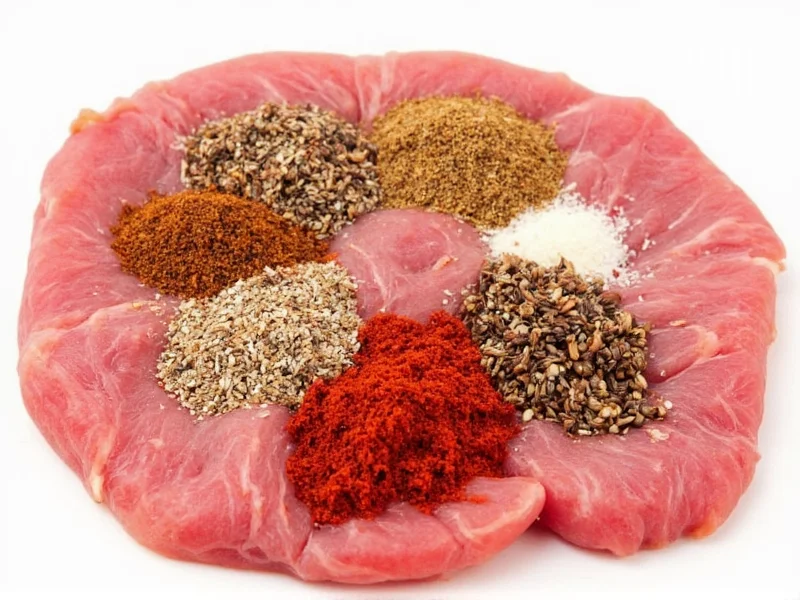When preparing corned beef, selecting the right spice combination transforms this humble cut into a flavorful centerpiece. The brining process that gives corned beef its distinctive taste also means the meat absorbs flavors differently than fresh cuts, making spice selection particularly important.
The Science Behind Spices and Corned Beef
Corned beef's unique flavor profile comes from both the curing process and the spices used during cooking. The salt preservation method changes how the meat interacts with aromatic compounds, creating a different chemical reaction than with fresh beef. Whole spices work better than ground varieties because they release flavors more gradually during the long cooking process, preventing bitterness while building complex layers of flavor.
Traditional Corned Beef Spice Blend Components
A well-balanced corned beef spice mix contains elements that provide:
- Warmth (allspice, cloves, cinnamon)
- Sharpness (mustard seeds, black pepper)
- Floral notes (coriander)
- Subtle heat (red pepper flakes)
| Spice | Flavor Contribution | Recommended Amount (per 3-4 lb brisket) |
|---|---|---|
| Mustard seeds | Sharp, pungent base note | 2 tablespoons |
| Coriander seeds | Citrusy, floral undertones | 1 tablespoon |
| Black peppercorns | Spicy warmth | 1 tablespoon |
| Allspice berries | Complex sweet-spicy note | 1 tablespoon |
| Whole cloves | Intense aromatic warmth | 1 teaspoon |
| Bay leaves | Earthy background note | 2-3 leaves |
Regional Variations in Corned Beef Seasoning
While the basic spice profile remains consistent, regional preferences create interesting variations:
Classic New England Style
This version emphasizes simplicity with just mustard seeds, coriander, and black pepper. Some cooks add a single bay leaf for subtle complexity without overwhelming the meat's natural flavor.
Irish Traditional Blend
Authentic Irish corned beef seasoning often includes additional cardamom pods and a small piece of mace for floral complexity. Many Irish recipes also incorporate a splash of Guinness stout into the cooking liquid, which complements the spice profile beautifully.
Spicy Texas-Inspired Version
For those who enjoy heat, adding 1-2 dried chipotle peppers along with extra black pepper creates a smoky, spicy dimension that works well with corned beef's richness. This variation pairs perfectly with cabbage cooked with bacon.
Creating Your Own Custom Spice Mix
Making your own corned beef spice blend offers several advantages over store-bought packets:
- Fresher flavors - Whole spices retain their potency longer than pre-ground mixes
- Customization - Adjust heat levels or eliminate ingredients you dislike
- Cost effectiveness - Buying whole spices in bulk costs less per use
- No additives - Avoid preservatives and anti-caking agents in commercial blends
To create a basic homemade corned beef seasoning, combine 2 tablespoons mustard seeds, 1 tablespoon each of coriander seeds, black peppercorns, and allspice berries, plus 1 teaspoon whole cloves in a small muslin bag or cheesecloth. For enhanced flavor, lightly toast the whole spices in a dry skillet for 2-3 minutes before using to release their essential oils.
Timing Matters: When to Add Spices
The timing of spice addition significantly impacts flavor development:
- Start of cooking - Whole spices added at the beginning create a deep, integrated flavor
- Middle of cooking - Adding delicate spices like bay leaves halfway through prevents bitterness
- End of cooking - Fresh herbs like parsley or dill added in the last 15 minutes provide bright top notes
For optimal results, add your spice blend at the beginning of cooking, but remove it after 2 hours if using a cheesecloth bundle to prevent over-extraction of bitter compounds.
Common Spice Mistakes to Avoid
Even experienced cooks sometimes make these errors when seasoning corned beef:
- Using ground spices instead of whole - Ground spices become bitter during long cooking
- Overloading on cloves - Too much clove creates medicinal flavors that dominate the dish
- Adding sugar unnecessarily - Corned beef already contains curing sugar; additional sugar can make it cloying
- Skipping the toast step - Toasting whole spices dramatically enhances their flavor contribution
Pairing Spices with Cooking Liquids
The liquid you use for cooking corned beef interacts with your spice selection:
- Water-based - Use a more robust spice blend as water extracts flavors less efficiently
- Beer-based - Reduce strong spices slightly as beer contributes its own complex flavors
- Broth-based - Use lighter spice amounts since broth already contains seasonings
For the best results with a traditional spice blend, use equal parts water and beer (like a stout or lager), which creates a perfect medium for spice extraction without overwhelming the meat.
Storing Leftover Spice Blends
If you make extra spice mix, store it properly to maintain freshness:
- Keep in an airtight container away from light and heat
- Use within 6 months for optimal flavor (whole spices last longer than ground)
- Label with date and spice combination for future reference
Properly stored homemade corned beef seasoning maintains its potency significantly longer than commercial packets, which often contain ground spices that degrade quickly.











 浙公网安备
33010002000092号
浙公网安备
33010002000092号 浙B2-20120091-4
浙B2-20120091-4